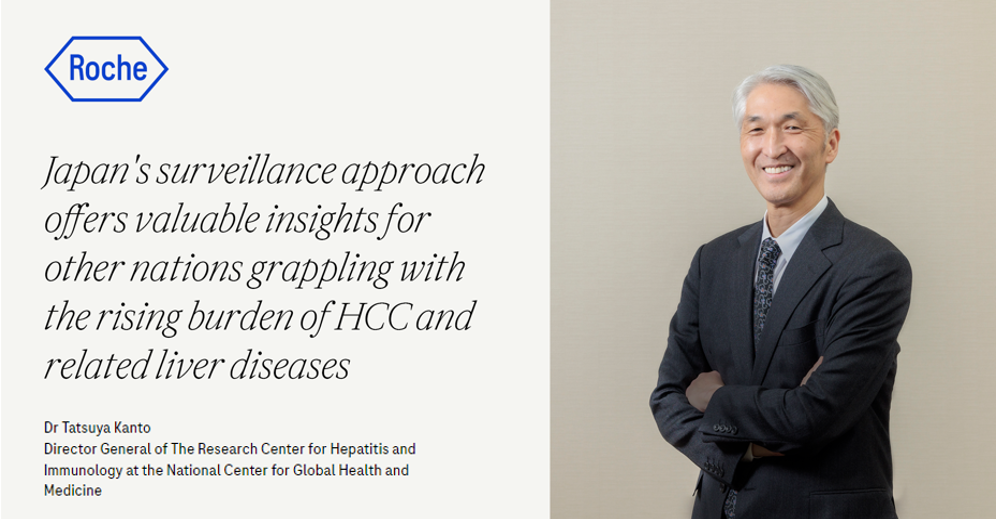Each year in Japan, around 41,388 new cases of liver cancer emerge, resulting in 26,420 deaths, making it the country’s fifth most common cancer.1 Despite this, Japan has emerged as a global leader in liver cancer surveillance due to its proactive approach to early detection. It is among 11 nations on track to eliminate viral hepatitis, the primary cause of liver cancer in the Asia-Pacific region, by 2030.
Dr. Tatsuya Kanto, Director General of The Research Center for Hepatitis and Immunology at the National Center for Global Health and Medicine, highlights the benefits of Japan’s surveillance program, which has significantly improved patient care and optimised healthcare spending.

What sets Japan’s surveillance program apart, and what are the key factors contributing to its success in managing Hepatocellular Carcinoma (HCC)?
Japan’s leadership in managing hepatocellular carcinoma (HCC), or liver cancer, dates back to the 1980s when it established a nationwide surveillance program. This program specifically targeted high-risk populations, including individuals with viral hepatitis and metabolic liver diseases like fatty liver, alcoholism, or type two diabetes. Notably, the program covered patient expenses and enforced rigorous screening guidelines, which included frequent tests at shorter intervals. Proactive screening and surveillance initiatives have led to a higher rate of detection of tumours at early stages, enabling the application of curative treatments and resulting in improved patient outcomes and extended survival rates. Notably, around 62% of liver cancer patients in Japan are diagnosed at stages A and B, with up to 44% surviving beyond five years,2 thanks to regular ultrasonography, tumour marker assays, and optional CT and MRI scans. A key to this success is the continuous evolution of government policies and funding support, underscoring Japan’s commitment to combating liver cancer and improving public health.
What preventive measures has Japan implemented, apart from its surveillance program, to address the progression of liver disease and liver cancer?
In Japan, hepatitis C virus (HCV) infection, constituting 60.3%, and hepatitis B virus (HBV) infection, at 12.9%, were identified as the leading and third-most common causes of liver cancer between 2008 and 2016,3 respectively. To combat the impact of these infections and reduce mortality rates from liver cancer, Japan has proactively implemented several countermeasures since the early 2000s. By instituting simple guidelines to identify individuals at risk and offering free hepatitis tests during routine health check-ups for citizens aged 40 to 70, Japan has substantially increased the rate of hepatitis virus screening. Notably, it has witnessed a decline in the estimated number of people with viral hepatitis – HBV decreased from between 1.31 to 1.47 million in 2000 to 0.98 million in 2011, and for HCV, it dropped from between 1.69 to 2.20 million to 1.58 million in 2011.4
Japan’s effective management of liver disease is also attributed to a collaborative healthcare model. Local governments, particularly prefectural ones, have been instrumental in reducing regional disparities by leveraging their knowledge of local demographics, healthcare infrastructure, and cultural norms. This enables them to target resources and interventions effectively, maximising impact and promoting health equity. By closely collaborating with central authorities and other stakeholders, prefectural governments have contributed to the successful implementation of nationwide initiatives such as public education and awareness campaigns, early screening promotion, and resource allocation for testing, treatment and healthcare worker support. These multifaceted preventive measures have positioned Japan among the 11 countries poised to eliminate the hepatitis virus by 2030, representing significant progress in addressing more severe liver diseases on a national scale.

How has Japan’s surveillance program reduced the economic burden of HCC?
Investing in a well-funded surveillance program is essential for effectively managing the disease and achieving significant cost-effectiveness. The economic burden of HCC encompasses hospitalisation costs, outpatient care costs, lost worker productivity, treatment benefits, and societal costs. As the economic burden increases with disease progression, preventing disease advancement becomes crucial for cost reduction. Early detection and treatment play pivotal roles in achieving this, leading to substantial cost savings by avoiding expensive procedures such as liver transplantation and hospitalisation for advanced liver-related complications. This ultimately reduces the overall burden of illness and improves patient outcomes. Analysis of the cost of illness (COI) in Japan reveals a downward trend, with a notable 33% decrease recorded in 2014 compared to 2002.5 Loss of human capital due to death caused by HCC was the largest contributor to COI.5 This suggests that the lower (and downward trending) COI in Japan could be attributed to the national surveillance program, which has led to earlier diagnosis and improved prognosis of HCC patients, demonstrating the cost-effectiveness of nationwide HCC surveillance.
Additionally, subsidy programs facilitate widespread access to testing, with local governments covering nearly all testing costs. In fiscal year 2022, the Ministry of Health and Labour allocated approximately USD $176 million for hepatitis countermeasures, with nearly half of the budget (USD $88 million) dedicated to treatment and a quarter (USD $40 million) to testing. Subsidy programs are instrumental in covering the expenses of essential diagnostic tests like ultrasound and tumour marker tests for HCC testing and surveillance.
What lessons can be gleaned from Japan’s HCC screening programs, and how might they guide similar efforts in other countries?
Japan’s surveillance approach offers valuable insights for other nations grappling with the rising burden of HCC and related liver diseases. While not all countries may replicate Japan’s substantial budget allocations, establishing a national surveillance program is crucial. Public awareness initiatives like the Shitte kan-en6 project featuring popular Japanese actors and singers have proven effective in encouraging early detection and treatment. Delegating execution to local governments and prefectures ensures responsiveness to local needs, providing a framework for setting policy objectives, standardised guidelines, and mobilising resources. Investing in medical personnel training is also vital. In Japan, over 20,000 medical care coordinators across prefectures play a pivotal role in public education, patient support, and post-treatment follow-up, offering a blueprint for comprehensive liver cancer management. By blending national leadership with decentralised implementation and targeted investments, countries can construct resilient healthcare systems to tackle liver-related diseases effectively, ensuring quality care.
References:
- Global Cancer Observatory. (2024). Statistics at a glance, 2022 [Report]. International Agency for Research on Cancer. https://gco.iarc.who.int/media/globocan/factsheets/populations/392-japan-fact-sheet.pdf
- Kudo M.(2018) Management of Hepatocellular Carcinoma in Japan as a World-Leading Model. Liver Cancer. 7(2):134-147. doi:10.1159/000484619
- Tanaka J, Akita T, Ko K, et al. (2019) Countermeasures against viral hepatitis B and C in Japan: an epidemiological point of view. Hepatol Res; 49:990–1002
- Enomoto H, Ueno Y, Hiasa Y, et al (2021) The transition in the etymologies of hepatocellular carcinoma-complicated liver cirrhosis in a nationwide survey of Japan. J Gastroenterol ;56:158–67
- Wu Y, Matsumoto K, Chen YM, Tung YC, Chiu TY, Hasegawa T. (2020) Comparison of the cost of illness of primary liver cancer between Japan and Taiwan. Health Economics Review;10(1):38. doi:10.1186/s13561-020-00296-7
- Takeuchi Y, Ohara M, Kanto T. (October 31, 2021) Nationwide awareness-raising program for viral hepatitis in Japan: the “Shitte kan-en” project. Glob Health Med; 3(5):301-307. doi: 10.35772/ghm.2021.01063. PMID: 34782873; PMCID: PMC8562092














